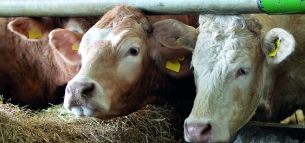Beef & Lamb Standards
Download Beef & Lamb Standards Manual
Download the changes to Beef & Lamb Standards from 1 February 2025
ANIMAL MEDICINES Version 5.0 (modified)
Click to view
Key – Those standards which have greater significance (all other standards are normal)
Recommendation – Those which do not affect certification
New – A completely new standard which the member must now adhere to
Revised – A standard that has changed and requires the member to take some different or additional action to before
Upgraded – The standard has been upgraded to a Key standard or from a Recommendation to a full standard
Appendix – Referenced in ‘How you will be measured’. Indicates that additional information is provided in the Appendices, which are available at the end of each section.
L.AM.1 Key
Only authorised veterinary medicines are used (REVISED)
How you will be measured
L.AM.1.a
L.AM.1.b
L.AM.1.d
L.AM.2 Key
Veterinary medicines must be used appropriately
How you will be measured
L.AM.2.a
L.AM.2.b
L.AM.2.c
L.AM.2.2
Prophylactic administration of antibiotics is only permitted in exceptional circumstances (NEW)
How you will be measured
L.AM.2.2.a
L.AM.2.2.b
- Rationale for prophylaxis (per prescription)
- Management review (group prophylaxis)
L.AM.3
Veterinary medicines must only be administered by demonstrably competent persons
How you will be measured
L.AM.3.a
Named in HHP or training records
L.AM.3.1
At least one person, who is responsible for administering medicines has undertaken training and holds a certificate of competence/attendance from training undertaken since October 2016
How you will be measured
L.AM.3.1.a
- Certificate of competence/attendance
- Training records
L.AM.4
Veterinary medicines must be stored appropriately
How you will be measured
L.AM.4.a
L.AM.4.b
L.AM.4.c
L.AM.4.d
L.AM.5
Purchase records for all veterinary medicines must be kept
How you will be measured
L.AM.5.a
L.AM.5.b
L.AM.5.c
- Medicine purchase records
- MFSPs (may be held centrally by parent company)
L.AM.6 Key
Records must be kept of all administered veterinary medicines (paper and/or electronic)
How you will be measured
L.AM.6.a
L.AM.6.b
Medicine administration records
L.AM.7
Veterinary medicines, their containers and administration equipment must be disposed of responsibly
How you will be measured
L.AM.7.a
L.AM.7.b
L.AM.7.c
L.AM.7.d
- Medicine disposal records
- Waste transfer note/receipt
L.AM.8.1
It is recommended total annual antibiotics used should be collated and uploaded onto AHDB medicine hub or Welsh Lamb and Beef Producers AMU Calculator or equivalent
L.AM.9 Key
Use of HP-CIA antibiotics (i.e. those belonging to Category B “Restrict”, as defined by the European Medicines Agency), must only be as a last resort, under veterinary direction
How you will be measured
L.AM.9.a
Vet statement
L.AM.10 Key
Prescribed withdrawal periods must be correct and complied with
How you will be measured
L.AM.10.a
L.AM.10.b
Withdrawal period declaration
L.AM.11
Procedures must be in place to deal appropriately with needles or part needles remaining in livestock
How you will be measured
L.AM.11.a
L.AM.11.b
L.AM.11.c
Broken needle policy
- For guidance on the responsible use of medicines visit: www.ruma.org.uk
- For guidance on veterinary medicine use including guidance on how to inject, visit: www.nadis.org.uk and the AHDB Better Returns Manual: beefandlamb.ahdb.org.uk/wp-content/uploads/2017/03/Using-medicines-correctly-for-better-returns-010317.pdf
- NOAH Compendium of authorised veterinary medicine datasheets: https://www.noahcompendium.co.uk/
More Standards
Download Beef & Lamb Standards Manual
Download the changes to Beef & Lamb Standards from 1 February 2025
- AM.1, AM.2 – A Veterinary Medicinal Product is legally defined as: any substance or combination of substances presented as having properties for treating or preventing disease in animals. Any substance or combination of substances that may be used in, or administered to, animals with a view either to restoring, correcting or modifying physiological functions by exerting a pharmacological, immunological or metabolic action, or to making a medical diagnosis.
- Veterinary medicinal products used to treat and prevent disease in farm animals include, but are not limited to, vaccines, ecto- and endoparasiticides, antibiotics, anti-inflammatories and anesthetics.
- POM-V stands for ‘Prescription Only Medicine – Veterinarian’ and these veterinary products may only be supplied upon prescription by a veterinary surgeon for animals under their care. All antibiotics for food-producing animals are classified as POM-V.
- POM-VPS standards for ‘Prescription-Only Medicine – Veterinarian, Pharmacist, Suitably Qualified Person (SQP, also known as ‘RAMA-Registered Animals Medicines Advisors)’ and these products may be prescribed by these registered qualified persons.
- The use of antibiotics as growth promoters is illegal.
- AM.3.1 – Courses include, but are not limited to, City & Guilds, NOAH/Lantra Antimicrobial Best Practice and veterinary led training courses, as approved by Red Tractor. A list of approved courses can be found on the Red Tractor Assurance website.
- AM.6.b – The required information does not need to be in a single location (e.g. a medicine book). It can be stored in a combination of documents. However, a farm must be able to demonstrate how the information can be collated to correlate administration of particular medicines to specific groups cattle and lambs so as to ensure the food chain is protected and any use of medicines is traceable. For example, medicines administered routinely to groups of animals, such as vaccines, need not be individually entered in the medicine book – a list in the VHP covering the necessary information will suffice
- AM.10 – Ensuring treated livestock are ‘identifiable’ may be achieved in different ways. It is not a specific requirement that treated animals are physically marked, although this is one way of ensuring animals are identifiable. The key is that it is possible, through systems employed on the farm, to identify treated animals to protect the food supply chain.
